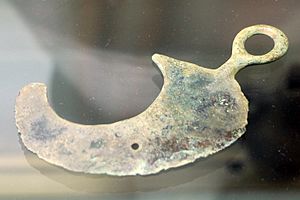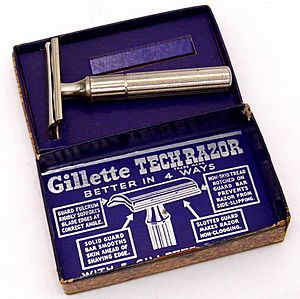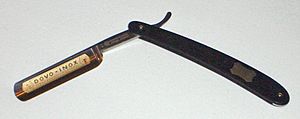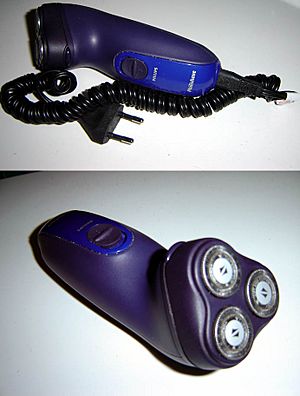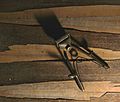Razor facts for kids
Quick facts for kids 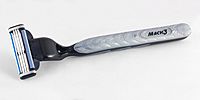
A modern razor with replaceable blade cartridges
|
|
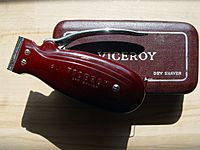
Spring-loaded Viceroy dry shaver made by Rolls Razor
|
|
A razor is a special tool that has one or more blades. People use razors to shave off hair from their bodies. Men often use them for their faces, and women use them for their legs and underarms. The first razors we know about are from the Bronze Age. They were made of bronze and shaped like an oval. Today, there are many types of razors, like straight razors, safety razors, and electric razors. Some electric razors are also used to trim and cut hair on the head, which is much faster than using scissors.
Contents
The History of Razors
Early Razors
People have used razors for a very long time. Razors from the Bronze Age were found in many different cultures. These early razors were made from bronze or obsidian (a type of volcanic glass). They were usually oval-shaped with a small handle, called a tang.
Before metal razors, people in ancient times used sharp things like clam shells, shark teeth, and flint to shave. Drawings of these early blades have been found in prehistoric caves. Some tribes still use flint blades today.
Archaeologists have found razors made of solid gold and copper in tombs in Egypt. These date back to about 4000 BC. In northern Europe, several razors were found in Bronze Age burial sites. These probably belonged to important people. The Roman historian Livy wrote that razors came to ancient Rome in the 6th century BC. A king named Lucius Tarquinius Priscus supposedly brought them. However, razors did not become common in Rome until about 100 years later.
Modern Razors Emerge
The first modern straight razors were made in Sheffield, England. This city was famous for making cutlery (knives and tools). In 1740, Benjamin Huntsman created a very hard steel using a special process. This steel was perfect for razor blades.
At first, people in England did not want to use Huntsman's new steel. But the French started using it, even though they were hesitant at first. When English manufacturers saw how successful it was in France, they finally adopted it too. Sheffield steel became known for its high quality and shiny finish. It is still used today by some razor makers in France.
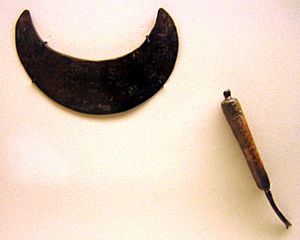
In the 18th and 19th centuries, only wealthy people could afford servants to shave them or go to barbershops. Most people did not shave every day. Daily shaving became common for American men after World War I. Soldiers had to shave daily so their gas masks would fit correctly. This became much easier with the invention of the safety razor, which was given to soldiers during the war.
The Rise of Safety Razors
Before the 20th century, straight razors were the most common way to shave. Barbers were trained to give quick and clean shaves with them. Barbershops often had many straight razors ready to use.
Straight razors started to become less popular. The first big change came from King C. Gillette. He invented a double-edged safety razor with blades that could be replaced. Gillette's idea was to sell the razors cheaply, sometimes even at a loss. But he made a lot of money from selling the replacement blades, which people needed to buy again and again.
These new safety razors were a huge success. They were advertised as being safer and easier to use than straight razors. People did not need special training to use them. The blades were hard to sharpen and were meant to be thrown away after a few uses. Even though straight razors were cheaper in the long run, the safety razor became very popular. As shaving became less scary, more men started shaving themselves, and fewer people needed barbers for straight razor shaves.
In 1960, stainless steel blades became available. These blades could be used more than once, which made shaving with safety razors cheaper. The Wilkinson company, famous for making ceremonial swords, made the first ones in Sheffield. Soon, other companies like Gillette and Schick also started making stainless-steel blades. After this, razors with multiple blades and disposable razors became popular.
Electric Razors
In the 1930s, electric razors became available. These razors use electricity to work. While an electric razor can be expensive, it can be cheaper than buying a full straight razor shaving kit.
Types of Razors Today
Straight Razors
Before the 20th century, straight razors were used by many people. A straight razor has a single, very sharp knife blade that can be used many times. Because the blade is so sharp, there is a high chance of cutting yourself. Today, straight razors are rarely used by most people, except by professional barbers.
Safety Razors
In the late 18th century, a French engineer named Jean-Jacques Perret invented the safety razor. This design protects your skin from most of the blade, making it much harder to cut yourself. The first safety razor was sold in 1875 by the Campfe Brothers.
In 1901, King C. Gillette invented the first razor with disposable blades. These blades were thrown away after being used a few times. How long a blade lasts depends on how thick your hair is and how you shave. On average, a disposable blade lasts about one week. The company Gilette still makes these razors today. They sell the razor handles at a low price and make most of their money from selling the replacement blades.
Electric Razors
For Face and Body Hair
The electric razor was a big step forward in shaving. With electric razors, you do not need shaving cream, soap, or water. Electric razors use electricity to make their blades rotate in circles or oscillate (move up and down or side to side). They are usually powered by a rechargeable battery. Prof. Alexandre Horowitz invented the idea of rotating blades, which is still sold as Philishave by Philips.
For Head Hair
There is a slightly different type of electric razor used to trim and cut hair on the head. These haircutting electric razors have comb-like attachments. These attachments help you choose how long you want the hair to be. Electric haircutting razors are often used by military and prison barbers. This is because they can cut hair much faster than scissors.
Side Effects of Shaving
Shaving can sometimes cause problems like cuts, scrapes, or irritated skin. You might also get "razor bumps" from hairs that grow back into the skin. To help avoid these problems, you can use a fresh razor blade. It also helps to wash your face with hot, soapy water and then put on shaving cream before you start. There is even a razor called Bump Fighter designed to reduce razor bumps, but it uses special cartridges that cost more than regular blades.
Images for kids


